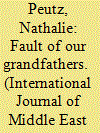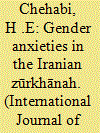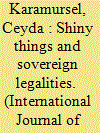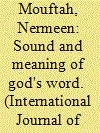|
|
|
Sort Order |
|
|
|
Items / Page
|
|
|
|
|
|
|
| Srl | Item |
| 1 |
ID:
167967


|
|
|
|
|
| Summary/Abstract |
This article traces a conflict that erupted in the late 19th century between the Armenians and the Süryani. This conflict, I argue, precipitated nothing less than the creation of the Süryani community itself. The dispute began over the key to a closet in the Church of the Holy Sepulchre, but it quickly evolved. Soon, the Armenians and the Süryani were clashing over holy places all around Jerusalem. The dispute centered on an Ottoman administrative arrangement which had been institutionalized nearly 400 years earlier: yamaklık. The Ottoman investigators, however, were unfamiliar with this archaic arrangement and had to be reeducated as to its terms and its history. The Süryani and the Armenians offered divergent accounts. Where the Armenians furnished hard documentation, however, the Süryani could produce only claims to tradition and local practice. In this article I argue that, through this protracted conflict, the Süryani came to understand the importance of the documentary record in a post-Tanzimat Ottoman world. They thus turned to an alternative strategy that would conform to this documentary sensibility and render their community visible to the state: a series of petitions with thousands of Süryani signatures from around the Ottoman Empire.
|
|
|
|
|
|
|
|
|
|
|
|
|
|
|
|
| 2 |
ID:
167964


|
|
|
|
|
| Summary/Abstract |
Drawing on ethnographic research conducted in Djibouti's Markazi camp for refugees from Yemen between 2016 and 2018, this article examines the complex motivating factors that drove a subset of Yemenis to seek refuge in the Horn of Africa. Although the primary reason for their flight to the Horn of Africa was the ongoing war, a secondary but not inconsequential driver of many of these Yemeni refugees’ current displacement was their family histories of transnational migrations and interethnic marriages. This article argues that, for this group, it was their “mixed” (muwallad) Arab and African parentage and resulting alienation in Yemen that made their flight imaginable—and, in their view, imperative. Although “mixed motive migration” is not unusual, this example underscores how spatial and social (im)mobilities in Yemen and the Horn of Africa region have been co-constituted across generations. More importantly, it has critical implications for the recently adopted Global Compact on Refugees, which promotes (among other solutions) the “local integration” of refugees in their proximate host societies.
|
|
|
|
|
|
|
|
|
|
|
|
|
|
|
|
| 3 |
ID:
167966


|
|
|
|
|
| Summary/Abstract |
The zūrkhānah is the traditional gymnasium of Iranian cities. Athletes exercised in a homosocial milieu that occasionally allowed for same-sex relations. Beginning in the 20th century, modern heteronormativity made such relations problematic, while gender desegregation allowed women to enter them. After the Islamic Revolution of 1979, gender segregation was again imposed, while heteronormativity was maintained. In recent years, women have endeavored to make the zūrkhānah more inclusive. This article analyzes the contradictions and paradoxes of gender relations in the zūrkhānah by using classical poetry, modern novels, anthropological accounts, autobiographies, travelogues, and press reports.
|
|
|
|
|
|
|
|
|
|
|
|
|
|
|
|
| 4 |
ID:
167968


|
|
|
|
|
| Summary/Abstract |
This article probes the legal expropriation of dynastic property in the late Ottoman Empire and early Turkish Republic. Focused on the period from Abdülhamid II's deposal in 1909 to the decade immediately following the abolition of the caliphate in 1924, it takes parliamentary debates as entry points for exploring how this legislative process redefined the sovereign's relationship with property. Although this process was initially limited only to Yıldız Palace, the debates that surrounded it heuristically helped to shape a new understanding of public ownership of property that was put to use in other contexts in the years to come, most notably during and after World War I and the Armenian genocide, before establishing itself as the foundation of a new ownership regime with the republican appropriation and reuse of property two decades later.
|
|
|
|
|
|
|
|
|
|
|
|
|
|
|
|
| 5 |
ID:
167965


|
|
|
|
|
| Summary/Abstract |
For centuries Muslims have asked whether the Qurʾan should be recited and memorized first and foremost, or whether one must prioritize understanding the meaning of its complex language. What is the best way to encounter God's Word? To explore this question, a women's Qurʾan lesson in a slum of Old Cairo illustrates modern Muslim anxieties over the place of discursive meaning in encounters with the Qurʾan. This article elaborates the concept of affirmation as an analytic to grasp how the women relate to the truth of revelation. Affirmation is a performative and discursive hermeneutic practice that deploys Qurʾanic citation, situates Qurʾanic concepts in daily life, and sutures the efficacy of Qurʾan education with correct language and with right action. Their lessons are indicative of reformist trends in Qurʾan education that open onto questions of meaning and understanding in relation to human interactions with divine speech.
|
|
|
|
|
|
|
|
|
|
|
|
|
|
|
|
|
|
|
|
|